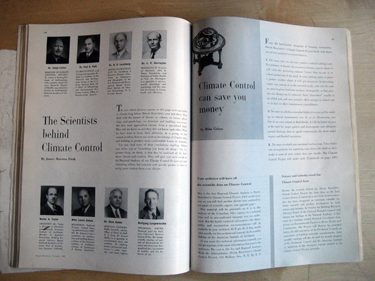A Machine for Climate:
The House Beautiful/AIA Climate Control Project
1949-1952
5.2 | The Researchers
The project was supported by an interdisciplinary team which wrote articles for both forms of publication. Dr. Paul A. Siple, a Climatologist and Military Geographer who worked at the Department of Army was one of the more prominent professionals involved. He was employed to analyze the data provided by the Weather Bureau 'for a series of cities and surrounding areas in terms of the implications for residential design'.19 He was aided by an anthropologist (Dr. Ralph Linton at Yale University), Dr. Helmut Landsberg (Executive Director Commissioner on Geophysics and Geography for the Research and Development Board in Washington DC), Walter A. Taylow (Director of Education and Research for the AIA), a doctor and scientific adviser for the Office of the Chief of Staff, US Army (Dr. Dana Coman), and Miles L. Colean who was a consulting architect and economist.
The two kinds of reports worked hand-in-hand. As a supplement to the House Beautiful studies, the public was encouraged to really get to know their environment through sensitivity and understanding.20 The house and yard as a unite were described as 'private climates' in line with the ideals of suburban living. Suggestions for climatic comfort were related to cost (changes that won't cost anything, ways in which a somewhat higher first cost will be made up in reduced maintenance cost, and the ways in which to avoid useless cost). Some efforts could be enacted by the individual homeowner while many required the services of an architect and landscape designer. The public was instructed to encourage their respective professionals to follow the AIA's climatic guidelines.
Alternatively, the House Beautiful articles functioned as a supplement to the AIA Bulletins as they were capable of garnering public support in the interest of design professionals who could provide higher quality, more efficient, and more aesthetically pleasing (and 'American') environments than the average developer. Furthermore, the AIA identified the importance for the architect to collaborate with landscape and planning professionals in maximizing climate efficiency, stating that 'Design for climate, with collaboration of the landscape architect, can turn marginal weather into good, lengthen the hours and season of outdoor living in any locality, and ensure maximum usefulness of the site for 12 months of the year. With this reliable data, the architect can design not only against the climate, but with the climate and site.'21
Click on the image below to meet the project team!
Photograph of House Beautiful magazine spread by author.
